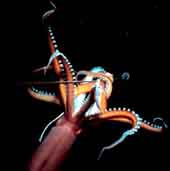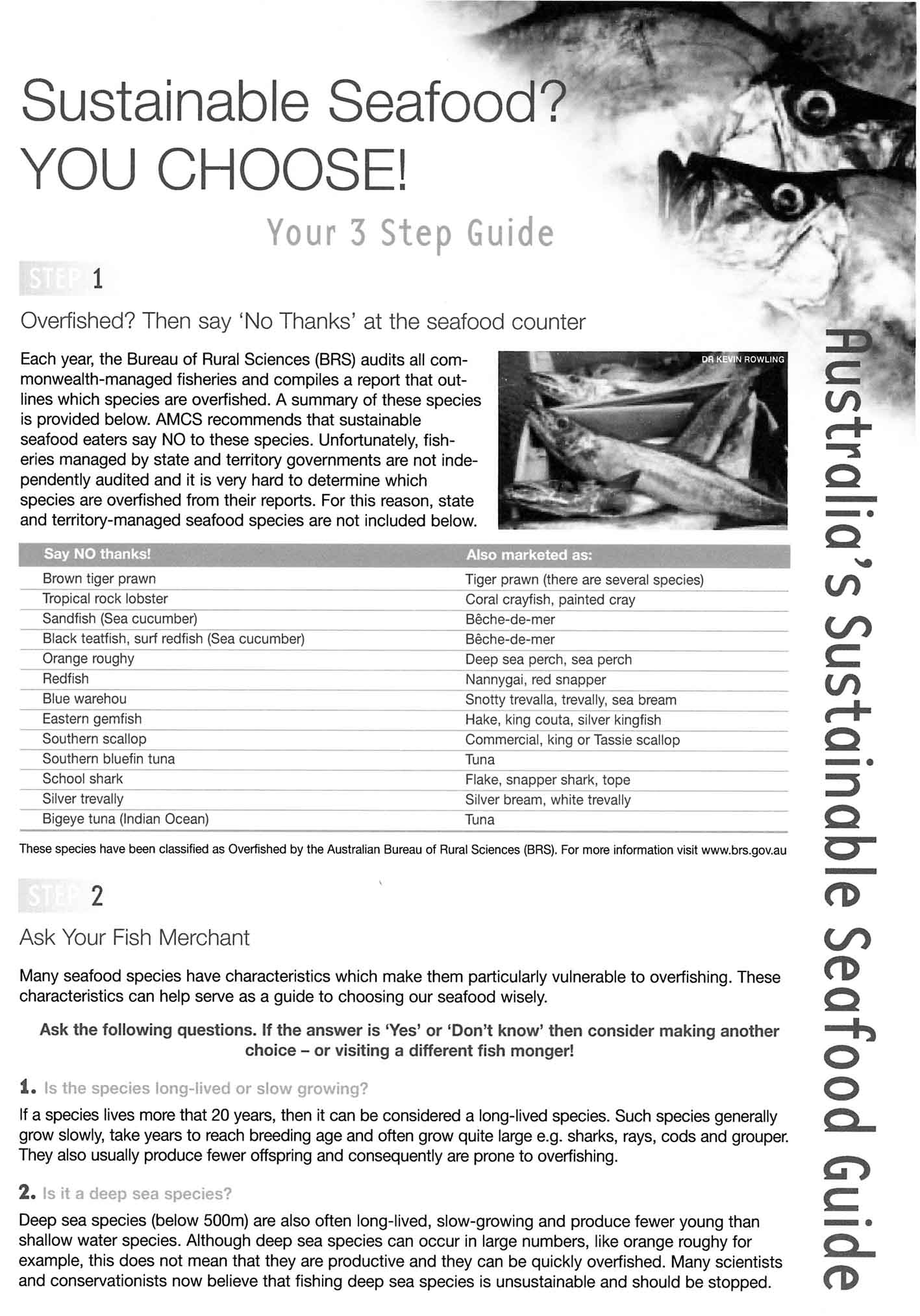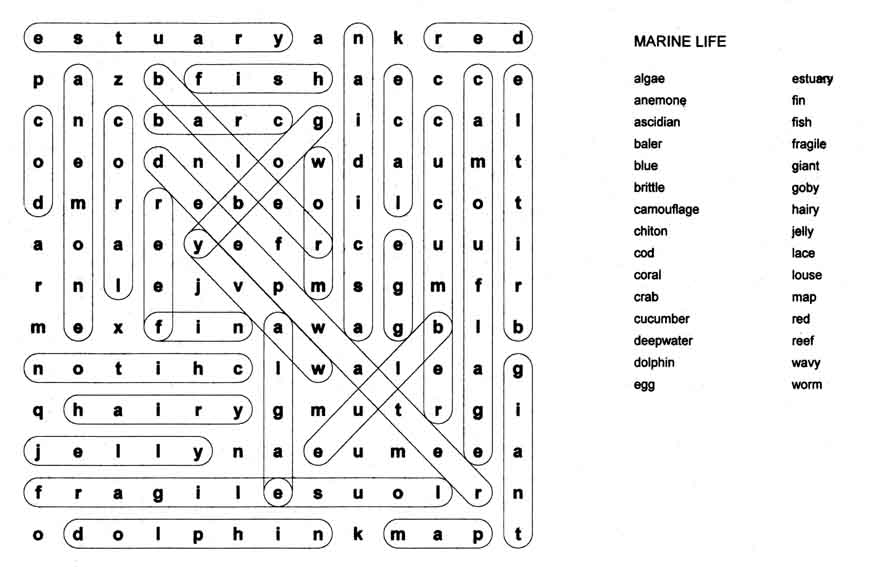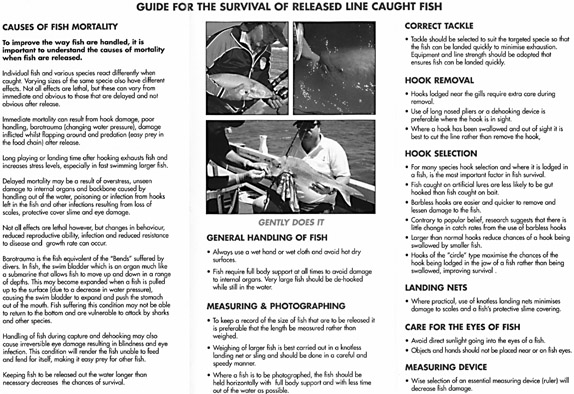Marine Life Society of South Australia Inc.
Newsletter
July 2004
No. 312"understanding, enjoying & caring for our oceans"
Next Meeting
Our July meeting will be held at the Conservation Centre, 120 Wakefield Street, Adelaide on Wednesday 21st July commencing at 7.30pm.
Our speaker will be MLSSA member Neville Skinner. His topic will be his dive trip to Kavieng. Slides will feature marine life, corals and some wrecks.
Contents
Here’s Looking At You, Squid
Great White Shark To Be Nominated For Cites Listing
Request For Information About Moonlighters
Prize-Winning Video
New University Research Centre Opened On KI
Choose your Seafood wisely – Its time!
Sustainable Seafood Guide (Page 1)
MLSSA Letter In Messenger Paper
June Wordfind solution
SARFAC Handling Fish for Survival leaflet
Contributors
This month our authors are Simon Benson (Daily Telegraph Environment Editor), Steve Reynolds, AMCS personnel and SARFAC.
Sustainable Seafood Guide
This is our centrefold and is the first of a two part publication. The second page will be published next month. I thank Craig Bohm of the Australian Marine Conservation Society for permission to publish them. Individual credits are on the pictures.
SARFAC Handling Fish for Survival leaflet
This is the middle half of a new SARFAC leaflet, well worth a read.
http://dailytelegraph.news.com.au/story.jsp?sectionid=1260&storyid=914660
February 18, 2004
The squid attached itself to a probe sent down by scientists, activated the camera shutter and snapped a picture of itself.
"The squid somehow managed to cling to the equipment encasing the camera and activated the shutter, taking this gorgeous picture of itself," an Australian Antarctic Division spokesman said.
"It’s taken at around 100m depth in the waters around Heard Island."
For the first time, a new world has been uncovered beneath the waters of the sub-Antarctic Heard Island through a marine research program aboard the Antarctic research vessel Aurora Australis.
Expedition leader, biologist Dick Williams, said pictures revealed a diverse array of animals on the sea floor.
They included commercial species such as the patagonian toothfish and mackerel icefish. Also shown are octopus and spectacular gardens of feather stars, sea anemones and soft corals.
"This is the first time scientists have been able to look deep into this part of the Southern Ocean, the world’s most powerful ocean," he said.
"Our use of this equipment was really a test run to see if it would do what we wanted.
"Until now we’ve only been able to guess at what it might look like, so we’re thrilled by the pictures of these bottom-dwelling invertebrates and fish in their natural habitats."

Great White Shark To Be Nominated For Cites Listing
We were recently asked to assist the Humane Society International by showing our support for the nomination of certain marine species for the Convention on International Trade in Endangered Species (CITES). The next CITES meeting is being held in Thailand in October. We obliged by sending a letter off to Dr David Kemp, Minister for Environment and Heritage.
We congratulated the Government’s previous nomination of the Great White Shark at CITES in 2000. We also congratulated Australia’s unilateral action to list the Great White Shark as an Appendix III species. We said that since the Great White Shark suffers continued and unsustainable international trade in its body parts, we hoped that Dr Kemp would renominate it for Appendix I in Thailand this year.
We also asked that the Australian Government nominate to list Nautilus under Appendix I and Patagonian Toothfish, Hound Sharks, Southern Bluefin Tuna and Orange Roughy under Appendix II species under CITES where international trade can be more adequately controlled. We asked the Government to also support nominations to list Maori Wrasse, Spiny Dogfish and the Indonesian Yellow-Crested Cockatoo to the CITES Appendices.
We can now report that Australia is pushing for a global ban on the trade in Great White Shark products. We (Australia) will nominate the shark for listing under CITES at the meeting in Thailand in October. Our thanks to Dr Kemp for his co-operation.
Steve Reynolds
Request For Information About Moonlighters
We recently received an email requesting information. It read: -
"Good evening!
I am trying to identify certain species of fish that may change their sex from either male to female or other wise, during their lifetime. Does the Moonlighter come into this category? I do believe that it comes in the category of SEXFASCIATUM ? Does this mean they are capable of this transaction?
Any information would be valuable in my studies.
Kind regards
Leigh Hart
San Remo, VICTORIA"
I sent off the following reply: -
"Hi Leigh
Re. your enquiry about the Moonlighter changing sex. I have not heard of this occurring in Moonlighters. I note that you are intrigued over the scientific name of Vinculum sexfasciatum. An earlier name for the same fish was Chaetodon sexfasciatus. But none of this has anything to do with changing sex. It's like the NZ version of six. Sex is actually Latin for six. In this case it probably refers to the six bands that give the moonlighter its other name of Six-banded Coral Fish. We would love to hear of your findings regarding other fish that change sex.
Regards
Steve Reynolds
MLSSA"
Prize-Winning Video
At our January General Meeting Ben Brayford showed us an excellent video by Englishman Charlie Oldfield. Charlie’s video was titled "The Secrets of Southern Australia". Apparently, Ben explained how Charlie was told to give up doing underwater videos because he was so bad, or something to that effect, and how he overcame the obstacles to be the best. Neville Skinner recently came across the results of the Beneath The Sea Worldwide Underwater Photography/Video Competition. He discovered the following listing: -
2004 COMPETITION WINNERS:
Video: 1st place: Charlie Oldfield, Nottingham, England - "The Shrimp and the Goby".
I’ve asked Ben to congratulate Charlie and suggest that he enters his video "The Secrets of Southern Australia" in the next competition. Well done Charlie.
Steve Reynolds
New University Research Centre Opened On KI
The University of Adelaide now has a new research centre. It is located in Flinders Chase National Park on Kangaroo Island. It has been named after Matthew Flinders and Nicolas Baudin. Dick Smith opened the new Flinders-Baudin Research Centre on 26th February 2004. He also made a donation of $20,000 towards the centre which was a collaborative effort between the university and the State Government. French, English and Australian companies also donated about $500,000 towards the centre which will concentrate on research into flora and fauna, resource management and restoration ecology. Associate Professor David Paton said that the centre will promote science, stimulate a new wave of research and facilitate field-based environmental teaching programs.
Steve Reynolds
Choose your Seafood wisely – Its time!
Have you ever made the link between your favourite seafood and whether the catch is sustainable or overfished? Have you ever asked your fish monger, supermarket or seafood restaurant how the seafood they sell was caught or farmed and by whom? Do they offer you any such information?
Increasingly, everyday Australians are concerned about the state of Australia’s fisheries, and the environmental impacts they cause, are asking these very questions in search for guidance to buying sustainable seafood. That does not just mean economically sustainable, but ecologically sustainable as well.
To help service growing public interest and help raise the profile of the plethora of environmental issues confronting Australia’s fishing and aquaculture industries, the Australian Marine Conservation Society (AMCS) has launched Australia’s first ever national guide to sustainable seafood.
What’s in the Guide?
§
A Sustainable Fish Finder§
A Sustainable Seafood Pocket Guide§
A conservation review of Australia’s commercial fishing gear§
A profile of Australia’s overfished orange roughy fishery§
Insights to seafood labelling and the lack of it in Australia§
An introduction to aquaculture – it’s no panacea!§
A revealing look at seafood imports - how many and what are they?But how much seafood do we eat?
Together, Australians eat over 206,000 tonnes of seafood each year, and our appetite is growing. Australia’s fisheries no longer catch as much seafood as we eat locally and today over 60 per cent of seafood is imported. By comparison, about 25 per cent of all farmed and wild caught seafood species are exported.
Although Australia has extremely diverse marine habitats, numerous species and very high levels of endemism (that is species that are found know where else in the world), Australia actually has very small fisheries in comparison to many other maritime nations. This is due to the low productivity and low nutrient levels in our seas. In fact, Australia ranks at only about 54th in the world in terms of our fisheries volume of production even though we have the largest fishing grounds in the world.
Unfortunately, we have adopted many of the industrial style fishing practices applied in many of the big northern hemisphere fisheries e.g. trawling, automatic longlining, 24 hour boat crews, advanced sonar and seabed mapping technology. Also over time, our governments have issued far too many fishing licences than are required to catch the seafood available. Today, extensive environmental impacts are the result. The lists of overfished and threatened marine species are growing longer and we have a major challenge on our hands to remove much of this fishing effort from our seas.
To support the work of AMCS and to receive your hard copy of Australia’s Sustainable Seafood Guide, call AMCS directly on
1800 066 299. The cost of the Guide is just $5 or 3 for $10 which helps cover printing and posting. Or you can access the information on the Society’s website by visiting www.amcs.org.auAMCS Recommends avoiding officially overfished species:
Orange roughy (sea perch)
Blue warehou (trevally, sea bream)
Eastern gemfish (hake, silver kingfish)
Silver trevally
Southern Bluefin Tuna
Big eye Tuna (from the Indian Ocean)
Also sharks (flake) and rays and deep sea fish which are slow growing and easily overfished.
Better choices include:
Whiting
Oysters
Tailor
Mullet
Bream
Squid

MLSSA Letter In Messenger Paper
The Guardian Messenger of 11th February featured a letter from our Society as follows: -
Toxic Toadfish
Members of the Marine Life Society of SA are concerned to read of the recent near death of a lady’s dog after it ate a toadfish found on a local beach ("Poisonous fish warning", Guardian Messenger, December 22).
We believe that part of the problem is due to children playing with toadfish which are highly toxic.
Live toadfish will swell up when threatened. It may be that children find some live ones and enjoy making them swell up.
We understand that toadfish are often thrown around by children on the beach.
It is not surprising that dogs come along and try to eat the toadfish, resulting in illness or death.
It is advisable then that children leave the toadfish alone.
It may even be possible that a child could become ill through handling a damaged toadfish.
At least a little knowledge about toadfish may help to save a child or a dog’s life.
Steve Reynolds
Secretary
Marine Life Society of SA
June Wordfind solution

SARFAC Handling Fish for Survival leaflet – inside section
